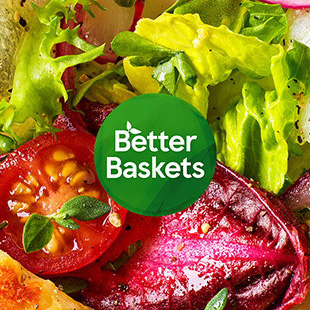- Tesco Resources
- Blog | Twixmas, Hogmanay, and Lunar New Year: engaging your customers beyond the post-Christmas lull
Blog.
Twixmas, Hogmanay, and Lunar New Year: engaging your customers beyond the post-Christmas lull
You’ve spent weeks planning for it. Days obsessing over every little detail, checking again and again to ensure that it’s all just right. All your hard work has been building up to this. And then… it’s over. In the blink of an eye, it’s done—and it’ll be the best part of a year before you have to think about it again.
Sound familiar? Then the chances are that you’ve either a) hosted Christmas lunch before, or b) have experience of planning a yuletide media campaign. Because, yes, just as millions of us spend hours ensuring festive perfection on our dining tables, media pros are similarly diligent when it comes to their activation plans.
There’s a difference, of course. Because, while you’re probably not expecting anyone to still be thinking about the lunch you made a week or more down the line, it’s a bit more important for shoppers to stick with you for the long term. Your Christmas campaigns might primarily be sales boosters in the run up to the 25th, but—with the right kind of thinking—they can also help you build loyalty past Boxing Day and beyond.

Tapping into Twixmas spirit.
The key here—much as it is with the likes of Halloween, Bonfire Night, and other seasonal events—is to focus on “mini-moments”. Just because Christmas is over, that doesn’t mean there aren’t opportunities to capture the mood of the moment and speak to customers in a way that’s reflective of their state of mind.
Take “Twixmas”, that recently-named period of time between Christmas and New Year’s. On the surface, it’s one of the quietest points of the year for grocery retail. After all, with those exuberant Christmas celebrations behind them, people are just hunkering down and working their way through a mountain of leftovers, aren’t they? Yes… and no.
When we look at some of the data we have from Tesco stores and Tesco.com in 2023, it’s clear just how quickly shoppers switch into New Year’s mode. On Boxing Day alone, for example, almost a million beers, wines and spirits units were sold, alongside more than 600k worth of frozen goods and over 3.5m purchases in the Impulse category.
That’s not all. In the six-day period between Boxing Day and New Year’s Eve, we saw:
- Searches for “fireworks” increase by 1,195%.
- Searches for “New Years” increase by 875%.
- And searches for “sparklers” increase by 726%.
Not everyone plans in advance, though. In fact, New Year’s Eve itself (or Hogmanay for those further north) is also a great time to engage with shoppers—particularly in Tesco stores. For instance:
- 33.8% of all Tesco customers have beers, wines, and/or spirits (BWS) in their baskets on New Year’s Eve. In fact, almost a quarter of the average basket is BWS-based on 31st December.
- Around one in 10 shoppers (7%) also have beauty products like fake tan and false lashes in their basket on New Year’s Eve.
- And, there are those all-important post-party purchases to think about, too. One in every 50 baskets on January 1st contains painkillers such as ibuprofen or paracetamol.
And with the arrival of January, of course, comes another rapid shift in mindsets. With the celebrations (more or less) wrapped up, the focus quickly turns to health, well-being, and sustainability.
Better Baskets: helping Tesco customers make better choices.
January’s always been a time for big ambitions, but traditional New Year’s resolutions like eating well and trying to do good for the planet have become increasingly institutionalised over the past decade. “Dry January” is now a well-recognised movement, as is “Veganuary”—with shoppers across the country choosing to forego meat and alcohol as they kickstart their new year.
These aren’t just social media fads, either. One person signed up for Veganuary every 2.4 seconds in 20231, and one in five people say they’d now opt for non-alcoholic beer by choice at a social event2. As those trends have gathered pace, so too have the opportunities for brands. 5.4m customers shopped plant-based foods in January last year, with low- and no-alcohol drinks attracting a similarly sizeable audience.

There are economic factors to consider here too, of course. For shoppers on a salary, January is one of the longest months of the year—the gap between December’s payday and the first of the new year requiring people to stretch their budget that much further.
With those things in mind, Tesco will again boost the visibility of its “Better Baskets” initiative in January 2025, aligned to the Veganuary, New Year - New Me, and Dry Jan customer mindsets. Better Baskets products offer healthier food that’s produced and packaged more sustainably. This initiative is designed to make better choices easier, more affordable, and more relevant and inspiring for customers than ever before.
Better Baskets products are instantly recognisable in-store and online thanks to the vivid green logo. To qualify for the initiative, a product must have at least one health or planetary benefit, as well as an accompanying price benefit for customers. Once their products have been nominated and approved, brands will have access to a full Better Baskets toolkit to help them activate in-store and online.
Going through that process is undoubtedly worth the effort. Close to 11m customer shopped Better Baskets products in Tesco stores alone last January, with online interest for related goods spiking throughout January too. Searches for “low calorie” foods rose by 288%, for instance, with “low fat” and “healthy” terms leaping by 193% and 192% respectively.
The Lunar New Year brings January to a colourful close.
Even at the very end of January, the party continues for many. Lunar New Year—widely celebrated by Chinese, Malaysian, Vietnamese, Singaporean, and Korean communities—falls on 29th January 2025. Food plays a big role in the festivities, and shopping behaviours shift accordingly.
Around Lunar New Year in 2024, for instance, sales of Asian rice at Tesco grew by 52%, noodles by 40%, oriental cooking sauces by 31%, and Asian oils by 29%. In total, 6.4m customers purchased more than 23m Lunar New Year-related items, spending 18% more during the event period than they did in the build-up to it.
From Boxing Day and New Year’s to January and beyond, the post-Christmas period now requires brands to be more agile than ever. Customer needs are constantly changing, sometimes in as little as a few hours. But with the right insights and channels at their disposal, brands can ensure that the “post-Christmas lull” is anything but and kick-start 2025 with a bang!

Tesco Media’s creative canvas can help brands connect with customers across the funnel. Contact your Client Partner to learn more about capitalising on the momentum gained post-Christmas and into 2025.

